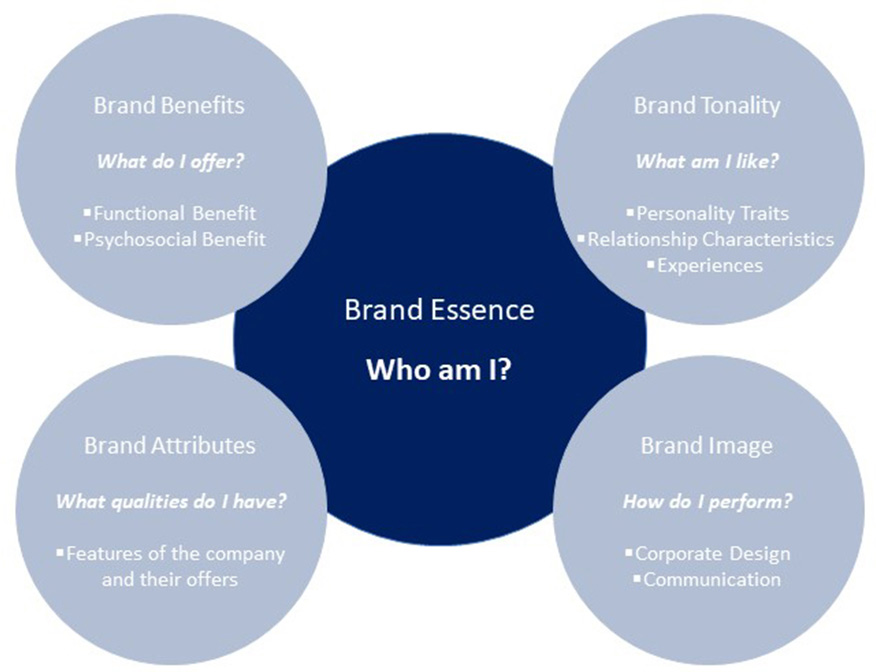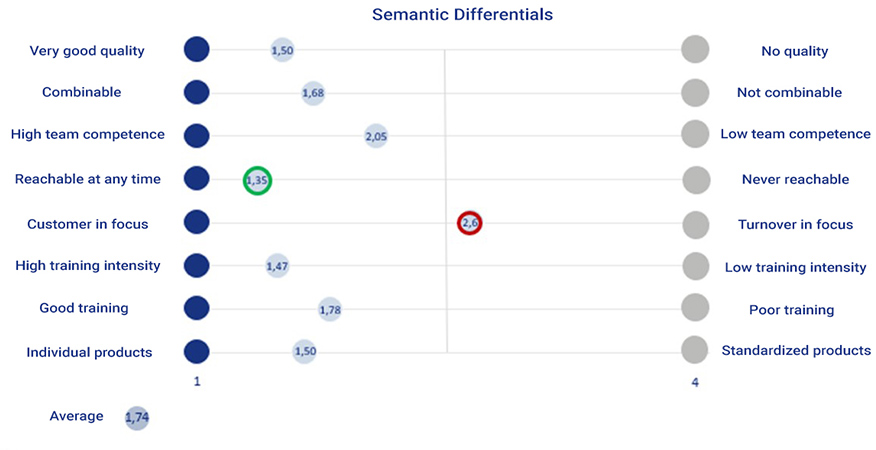
The Image Analysis - Why it is important for companies to address their brand’s self-image and external image
As specialists for market analysis and strategy consulting, DTO is often thematically very close to products and (potential) sales markets of customers. But we also intensively accompany the "look inside", by uncovering motives and psychological processes. The image analysis is a central tool to create a picture of one’s own company together with their customer. The central question our clients ask themselves: Do customers and stakeholders perceive us in the same way or approximately the same way as we perceive ourselves? In our technical article, we explain the opportunities that arise from the intensive examination of the opinion and perception of one's own company (core aspect: "Who are we"?) and the comparison with the image of the stakeholders (core aspect: "The company is...").
There is hardly a company, no matter if startup, small business, medium-sized company or big player, which refrains from communicating values to the outside world. Values such as: Reliability, Competence and Loyalty. But are these values daily practice or are they empty words that ultimately have little meaning?
Who should define corporate values?
Values should be valid and at the same time have enough individual character to be perceived by target groups. Therefore, it is of great importance to look inward and ask yourselves: Who are we actually? What makes us special? What is our brand claim? What makes up our sales department? Our products? It is essential to ask as many people in the company as possible. An ivory tower decision regarding the value definition only on the part of the management should not be the goal, but: involve the employees! Preferably from different disciplines and hierarchical levels.
The Image Analysis: What you need to know
The image of a company and its brand is made up of various factors and is one of the foundations for its economic success. The image analysis determines, within the framework of a target-performance comparison, whether the brand self-image of the company - e.g. strengths and weaknesses of the brand - corresponds with the external brand image of customers and non-customers and how, for example, the competition is perceived in comparison. DTO offers workshops including consulting and recommendations for action on the resulting results and findings. In these one-day workshops, which usually last several hours, DTO can support by:
- Existing values are reflected upon with the client and, if necessary, expanded.
- The first reflection on values takes place and these are then collected together. (Die erstmalige Reflektion über Werte stattfindet und diese dann gemeinsam erhoben werden.)
How can an image analysis be structured in terms of content?
In order to be able to analyze the brand image, individual factors can be broken down and related to each other. The model given below represents a possible starting point.

DTO Brand Model (2021)
The central instruments of a typical image analysis include:
- The brand analysis (brand core analysis)
- Target and stakeholder analysis
- Self-image analysis
- External image analysis
- Comparison with competitors
- Recommendations for action
Why is it important to deal with brand self-image/brand external image?
It is undeniable that reflecting on one's own company requires an openness that is not necessarily self-evident. Especially when a company is prospering economically, the necessity is often not seen. But: On what basis is the business success actually built? Are the employees satisfied and able to identify with the company? Is the outward image of fairness and respect also lived internally? Particularly in times of upheaval, commitment to the company, both internally and externally, is the cement that can hold everything together. A decisive aspect in the conflict between brand self-image and brand external-image: dissatisfaction is communicated more than satisfaction. If everything goes according to conception, this state is taken for granted. Which in turn means that it is not possible to draw conclusions about a completely dissatisfied group from a few negative evaluations. A negative external image can, however, also show itself in economically relevant consequences: Image damage, loss of credibility, etc. With a mixture of qualitative and quantitative market research, a basis of evidence can be created through sound facts and figures to determine the areas in which dissatisfaction comes, whether it is always the same positions and how these problem areas can be remedied.
Target and stakeholder groups
Image analysis differentiates between users (customers) and non-users (potential customers). Ultimately, a differentiation can be made between users who know the company and thus currently use the services, and non-users who know the company but currently do not (or no longer) use the services. There can also be different stakeholder groups. For example, purchasing is just as much a stakeholder group as, say, a senior physician. However, while purchasing tends to look at the products of the customer company with "economic glasses," users tend to focus on the handling and quality of the products.
Methodology
DTO combines primary sources (field research and direct investigations, e.g. surveys) with secondary sources (analysis and evaluation of available, e.g. sales statistics) and applies qualitative market research (guided expert/ internal interviews or group discussions) as well as quantitative market research (standardized, programmed questionnaires on large samples). The brand self-image can be obtained by an internal, anonymous survey or already available data of the client. For external analysis and comparison with the competition, samples are collected as needed from the DTO network and/or from our partners with network-strong online panels. The method mix is adapted to the respective project conditions. By combining different methods and survey modes, DTO is able to build image analyses in a modular way (e.g. a breakdown of a topic by survey country) and to analyze and compare several target and stakeholder groups separately. An example of a quantitative survey method are so-called "semantic differentials", which make it possible to distinguish between target groups or between customers and non-customers etc. by means of pairs of opposites on a four-point scale (see e.g. the following graphic). Semantic differentials make it possible to compare the assessment of the external image with the assessment of the self-image. In the example below, a rating of 1 would mean an optimal fit with self-image. In the graph, you can see that the item "available at all times" is positioned closest to the self-image with 1.35, while the contrasting pair "customer in focus/sales in focus" tends to move away from the self-image (2.6). Via this method, it is easy to facilitate a fit between external and self-image. In these pairs of opposites, the focus was on the team and the products. It is also possible to relate this to the customer company in general. Examples of contrast pairs: modern/conservative, local/global or also close/distant.

Semantic differentials according to DTO (2021)
An example of a qualitative survey method are guideline-based expert interviews, in which the advantages and disadvantages of the product and the competitor's products can be stated more explicitly.
Aim of the image analysis
What wishes and suggestions for improvement do the target and stakeholder groups have? The goal of the image analysis is to optimize the brand with a view of the positive and negative feedback. The analysis subjects the self-image to a target-performance comparison and, in the event of a lack of agreement in certain areas, draws up strategies for bringing the external image closer to the self-image. Both suggestions for improvement/comments from users and the reasons given by non-users of the product are highly interesting and offer room for maneuver for adjustments and further developments of the product as well as the sales and marketing strategy.
Additional information
If you need further information about an image analysis or would like to conduct an image analysis, please do not hesitate to contact us. Thanks to our specialists and a reliable partner network of industry experts, we are in a position to quantitatively and qualitatively ascertain the brand's self-image, external brand image and comparison with competitors, to prepare and analyze it in a clear manner and to provide you with recommendations for action.
Text written by Ramona Lautenbach and Kai Wichelmann